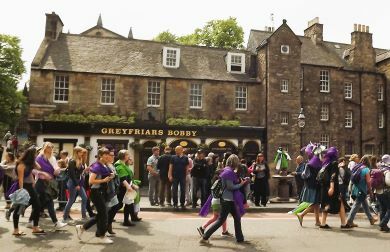Having read part one, you will be interested to know that Folktales from the Scottish Highlands does not purely focus on John Francis Campbell. It even extends beyond that!
Ossian and Fingal
James MacPherson was a Scottish writer from the 1700s, known primarily for his controversial works related to Scottish Gaelic poetry, published in the 1760s.
Macpherson claimed that these poems were translations of ancient Gaelic poetry he had collected during travels in the Scottish Highlands. The poems were attributed to a legendary Gaelic bard named Ossian. According to Macpherson, Ossian was a third-century bard who composed epic poetry recounting the heroic deeds of ancient Scottish warriors.
James’ works became an international sensation. Ossian was hailed as ‘the Scottish Homer’. Many readers of Macpherson’s Ossianic epics doubted that Scotland had such a rich heritage, believing James’ writings to be ‘fake’. Entirely his own invention.
Ossian is known in Ireland as ‘the son of Fingal’.

Photo Credit: Fraser Paterson - with kind permission of the National Library of Scotland
Mary MacPherson
Mary was a notable figure in Scottish Gaelic literature, known for her contributions as a poet. Born in 1716 in Badenoch, Scotland, she was a member of Clan MacPherson. Mary MacPherson is often referred to as "Màiri Mhòr nan Òran" (Big Mary of the Songs) to distinguish her from other women of the same name!
She composed poetry in the Gaelic language, focusing on themes such as love, nature, and traditional Highland life. Her work reflects the cultural and linguistic richness of the Scottish Highlands during the 18th century.
Mary MacPherson's poetry is celebrated for its emotional depth, lyrical beauty, and contribution to the Gaelic literary tradition. Her work provides valuable insights into the language, culture, and experiences of the Scottish Highlands during her lifetime.
Despite the challenges faced by Gaelic poets in preserving their work during a period of cultural transition and upheaval, Mary MacPherson's poetry has endured through oral tradition and written collections, ensuring her legacy as a significant figure in Scottish Gaelic literature.
She also understood the significance of weaving tartan to symbolize the Highland way of life. Mary wore tartan during rallies protesting against the destruction of crofting communities.
Mary also traveled with many other Scottish women, to attend the release of Women’s suffrage activist Mary Phillips from Holloway Prison, London. Mary and her fellow suffragettes all wore tartan sashes, apparently in the spirit of Scottish independence leader William Wallace from the late 1200s!
We had a commemorative suffragettes’ march in Edinburgh a few years ago, of which I took several photographs.

© Fraser Paterson - Suffragettes Commemorative March 2020 Past Greyfriars Bobby
Great Scottish Bard (poet) Rabbie Burns
Rabbie Burns lived during the late 1700s.
I could write forever on the wonders this man has done and continues to do, for Scottish culture and heritage. However, let us stick to just one of his best-known poems, Tam o’Shanter. He wrote this in 1790, for author Francis Grose’s Antiquities of Scotland, published the following year, the very year Francis died!
Grose’s work included detailed engravings and descriptions of castles, churches, abbeys, and other structures, providing valuable insights into the country's architectural heritage.
Burns’ contribution was written to accompany an entry for Alloway kirk (in the Ayrshire region, found in the southwest of Scotland) for Antiquities of Scotland.
Francis was also known for his interest in folklore and the supernatural. He compiled collections of ghost stories, legends, and superstitions, which were published posthumously under titles such as The Antiquarian Repertory and A Provincial Glossary.
Tam o’Shanter – a tale of a farmer’s supernatural encounter on his return from a night out drinking – we often say “on the bevvy” in Scotland! – with friends, became one of the Burns’ most popular works and made Tam an icon of Scottish culture.
I hope you have enjoyed your read! To make it possible for me to keep writing for your enjoyment, I would appreciate it greatly if you were generous enough to Buy Me Coffee, please.
Thank you.
Fraser Paterson
Freelance Writer and Tour Guide
